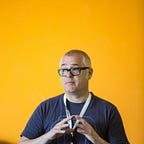Re(Frame) – Set Your Service Design Vision on course with this Rhetorical re-framework
Questions to consider, research and align at the early stages of service design.
The sequence of 11 questions is intentional–but use them in any order that works and let me know if they help. Every question also has a set of considerations to explore and go into extra depth if needed. Please let me know your thoughts and if any changes are needed at john.knight@aalto.fi
- What is the mission?
- What is the problem, opportunity, options and possible solutions?
- What are the risks and rewards?
- What is possible and impossible to do?
- What is the impact?
- How does the outcome sustainably generate value?
- What are the elements of the experience?
- How is value co-created and consumed?
- What happens after design?
- What is the best way to complete the mission?
- What is the design rationale?
© John Knight, Aalto University 2012
Citation:Knight, J. Jones, S, Sayar, D, Copeland, D and Fitton, D. (2020). Do It Fluid: Innovation in Smart Conversational Services Through the Flow Design Approach. In:Smart Systems Design, Applications, and Challenges, João M.F. Rodrigues, et al., [eds] IGI Global, 2020, pp. 238–258. http://doi:10.4018/978-1-7998-2112-0.ch012
First published:May. 06, 2012
Service Design Questions and Considerations
1. What is the mission?
- Does the mission align with our strategy and values?
- What happens if we do or don’t do the work?
- Who is involved?
- What assets, information and data do we already have?
- What is the size of the problem/opportunity?
- How accurate and stable are the requirements?
- What are the key service elements?
- What is the outcome?
- What barriers are there?
- Are the timescales achievable?
- When is the best time to deliver the outcome?
- Do we need to do this now?
- What else could we do?
- What barriers are there?
- Do we agree on what needs to be done?
2. What is the problem, opportunity, options and possible solutions?
- What is causing this problem and opportunity?
- What is driving the need to deal with it?
- Why is this an important issue?
- What must the solution do?
- What must the solution not do?
- What could the solution do?
- What could the solution not do?
- Is there an expensive fix?
- What are the cheap alternatives?
- Where is the biggest opportunity? Content, UI, Tech? etc
3. What are the risks and rewards?
- Is there a compelling business case?
- Is there a compelling reason for growth, organisation or customers?
- Is there enough research?
- Are we able to do the right thing?
- Is the vision and roadmap clear?
- Are we being over cautious or ambitious?
- What could go wrong in development?
- What could go wrong when live?
- Is there clarity on what needs to be done?
- Is there clarity on the solution?
- Is there sufficient audience/domain knowledge to do it?
- Is there insight on competition/best practice to follow?
- Is there too limited scope for improvement/design/change?
- Are there a limited number of alternatives available?
- Are we being over ambitious/cautious?
- Is the scope deliverable/requirement unclear?
- What could stop the service in the water?
4. What is possible/impossible?
- Are the requirements fixed?
- What is the obvious solution?
- What are the less obvious solutions?
- What is the right thing to do?
- Can we do the work properly?
- Do we have the right support from other teams?
- Do we have the right team and skills?
- Do we have the management support?
- Does the work align with other team’s priorities?
- Is the right technology and tools available?
5. What is the impact?
- How does the work affect the platform?
- How does the work affect the experience ?
- How does the work affect the business model?
- How does the work affect our customers?
- How does the work affect our people?
- How does the work affect our sustainability?
- What problems might the solution cause?
- What are the business/human risks/benefits?
- Who & what will be affected/involved? & how?
- What support/resource is needed before, during and after use?
- What are the best/worst potential outcomes?
6. What are the key service elements?
- Who — audience/user/profiles?
- What — use cases/scenarios/inputs + outputs
branding/design guidelines? - Where — context of use?
- Why — business/personal/social drivers?
- How — components, standards, data, tech etc?
7. How is value co-created and consumed?
- Personal — worth to the person?
- Social/cultural value?
- Economic — financial worth?
- Ethical — force for good/bad?
8. What happens after design?
- How will the service be known through awareness?
- Adoption?
- First use?
- Bonding?
- Familiarity?
- Habitual use?
- Improvisation?
- Attachment?
- Detachment?
- Is the organisational design feasible?
- When and how will the service be self-sustainable?
- What is the cost of production and operation?
- What is the operating model?
- How will service operations work?
- What kind of vision, mission and values will the service manifest?
9. What are the candidate solutions
- Best
- Acceptable
- Easiest
- Innovative
- Safe
- Worst
10. Is the proposed service right
- Accessibility
- Usability
- Service Flow
- Engagement
- Delight/pleasure/fun
- Flow, the peak+ebb/in the moment experience
- Fit with everyday life/practice
- Personal/social reward/benefit
- Sustainability
- Are there other relevant qualities?
11. What is the design rationale?
- At least three alternative solutions considered ideally from a long-list
- Design is evidence based and assumptions/risks known
- Everything extraneous has been removed
- Solutions meet requirements and can be measured
- Solution is feasible and well communicated
- A case is made for the solution
